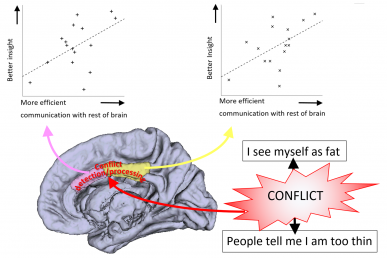Abnormalities found in ‘insight’ areas of the brain in anorexia
Abnormalities in brain regions involved in forming insight may help explain why some people with anorexia nervosa have trouble recognizing their dangerous, dysfunctional eating habits.

Insight may be impaired in people where connections between areas of the brain involved in conflict detection are abnormal.
In a study of structural brain connectivity led by the University of Illinois at Chicago and UCLA, those participants with anorexia nervosa who scored lowest on a test measuring their ability to form insight had more connective abnormalities than other patients in brain regions linked to error detection and conflict monitoring as well as self-reflection. Individuals with body dysmorphic disorder shared some of these connective abnormalities. The research was published in the journal Psychological Medicine.
Anorexia nervosa, a potentially life-threatening eating disorder characterized by self-starvation and excessive weight loss, and body dysmorphic disorder, in which individuals are preoccupied with misperceived flaws related to their physical appearance, are related psychiatric disorders that involve distorted body image, obsessive thoughts, and poor insight. The two often occur together, with symptoms usually first appearing during adolescence.
Anorexia nervosa patients who have poor insight may not respond well to treatment because they fail to realize that their behavior and dangerously low weight are damaging to their health, and may even lead to death.
“The brains of people with anorexia nervosa who have poor insight may not generate an ‘error message’ when told, for example, that they are putting themselves at serious risk for death by severe restricting,” said Dr. Alex Leow, associate professor of psychiatry and bioengineering in the UIC College of Medicine and corresponding author on the paper. “Thus, it is plausible that their brains literally don’t believe that they are severely underweight and their behavior is dangerous even when objective evidence suggests otherwise.”
The abnormal brain network in people with anorexia nervosa comprises several brain regions, including the caudal anterior cingulate and the posterior cingulate, which have been shown in other studies to be crucial for error detection, conflict monitoring, and self-reflection. For example, the caudal anterior cingulate is hyperactive in people with obsessive compulsive disorder, who may perceive problems where none exist, such as thinking the door may be unlocked even after checking it numerous times.
“Our results suggest that in order to have insight, you have to be able to see a conflict or error when your perceptions differ from those of others, or from reality,” Leow said.
“For example, in people with anorexia nervosa, that conflict might be, ‘I may actually be way too thin, even if I think I am still fat.’ Next, they need to be able to reflect on that conflict and what it means. If they can, this insight can lead to adaptive decisions, such as ‘Hey, I need to get help to change my behavior and get healthy,’ and then that person has a better chance of recovering.
“But without that insight, they are stuck.”
Leow and her colleagues explored differences and similarities in brain connectivity patterns in 24 weight-restored individuals with anorexia nervosa (participants met all criteria for anorexia except for amenorrhea and all had body mass indices (BMI) of 18.5 or higher), 29 participants with body dysmorphic disorder, and 31 healthy control participants. None were receiving psychiatric medication at the time of the study. Insight and delusionality were measured using specialized questionnaires.
Leow said the selection criteria for participants were carefully chosen, because long-term starvation itself has a profound impact on the brain and could contribute to abnormal connectivity in brain networks.
“We didn’t study individuals who were currently very underweight, because we didn’t want active starvation to impact our results,” she said. “In that case, we wouldn’t really be sure if network abnormalities were caused by the disease itself, or if they simply reflected current effects of starvation on the central nervous system.”
The researchers imaged each participant’s brain using structural magnetic resonance imaging and diffusion-weighted imaging. Next, they constructed maps for each participant that showed which areas of the brain exhibited high levels of connectivity.
They found that connectivity in the caudal anterior cingulate and the posterior cingulate were poorly connected with the rest of the brain in those with anorexia nervosa compared to healthy participants. Participants with worse insight scores had worse integration of these areas in the brain.
The researchers also found that individuals with anorexia nervosa had abnormal, overlapping brain networks involved in reward and compulsive behaviors.
“This could relate to the observation that many anorexics experience a rewarding feeling from ‘successfully’ carrying out compulsive exercising, restricting, achieving specific weight goals,” said Leow. Participants with body dysmorphic disorder showed similar but weaker abnormalities in the same regions.
Improving anorexics’ ability to detect the mismatch between their perceptions of self and reality may be the key to helping some recover, said Leow.
“We may be able to teach insight to these patients using different tools or techniques including virtual or augmented reality technologies,” Leow said.
A candidate approach is to ‘amplify’ the error signals, she said. “Many anorexic patients with poor insight are able to understand someone else’s severe restricting is very dangerous for that person, but they can’t see it for themselves even when they are doing exactly the same thing,” Leow said. Providing better visual feedback signals could be a way to get the error message across.
Co-authors on the paper are Aifeng Zhang and Johnson GadElkarim of the UIC College of Medicine; Teena Moody, Michael Strober and Jamie Feusner of the University of California, Los Angeles; Sahib Khalsa of the University of Tulsa in Oklahoma; and Liang Zhan of the University of Wisconsin-Stout.
This research was supported by National Institute of Mental Health grant R01 MH093535.
